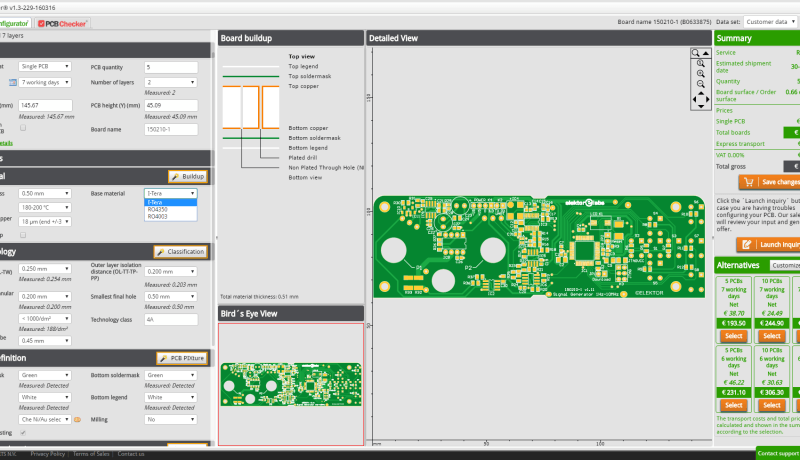REVIEW: RF Pool, professional PCBs for RF applications
March 25, 2016
on
on

When you are working with radio-frequency (RF) circuits you will have to be aware that the circuit board itself can have an influence on the RF signal. In particular for RF-applications, there is the availability of the RF-service from Eurocircuits. In addition to a comprehensive mass-production service for RF circuit boards, Eurocircuits also offers RF-pooling, so that you can have professional prototype circuit boards made in small quantities that will be appropriate for RF-applications.
The most important difference compared to PCB proto (which we looked at last month) is the base material that is used for the circuit board. Instead of FR-4, the material used here is I-Tera® MT RF from Isola Group. If desired, you can also choose to use RO4350 or RO4003 from Rogers Corporation, but in that case you cannot make use of the pooling service. These materials distinguish themselves from FR-4 by their (much) lower dissipation factor (Df) and a lower dielectric constant (DK). These characteristics have a direct impact on the effect that the PCB material has on signals in the GHz range. For signals above 500 MHz these characteristics are essential if your circuit is to operate as intended. In addition, these materials are very good at withstanding changes in temperature and exhibit very little distortion over large variations in temperature.
HAL Leadfree is not available for the final finish. The standard finish is Che Ni/Au selective, that is ENIG – Electroless Nickel plating, Immersion in Gold (without current, so chemical deposition of a layer of nickel then dipping in gold). This results in a good resistance to oxidation and optimum overall characteristics of the circuit board.
The most important difference compared to PCB proto (which we looked at last month) is the base material that is used for the circuit board. Instead of FR-4, the material used here is I-Tera® MT RF from Isola Group. If desired, you can also choose to use RO4350 or RO4003 from Rogers Corporation, but in that case you cannot make use of the pooling service. These materials distinguish themselves from FR-4 by their (much) lower dissipation factor (Df) and a lower dielectric constant (DK). These characteristics have a direct impact on the effect that the PCB material has on signals in the GHz range. For signals above 500 MHz these characteristics are essential if your circuit is to operate as intended. In addition, these materials are very good at withstanding changes in temperature and exhibit very little distortion over large variations in temperature.
HAL Leadfree is not available for the final finish. The standard finish is Che Ni/Au selective, that is ENIG – Electroless Nickel plating, Immersion in Gold (without current, so chemical deposition of a layer of nickel then dipping in gold). This results in a good resistance to oxidation and optimum overall characteristics of the circuit board.
Read full article
Hide full article



Discussion (0 comments)